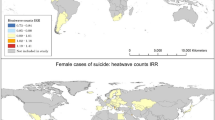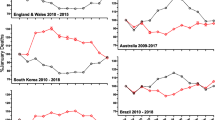Abstract
We aimed to reveal the relationship between the meteorological variables and suicide rates (completed suicides and suicide attempts) independently of the seasonal cycle and holiday effects. This is an observational retrospective study. We collected the data on age, gender, and suicide method of all suicide cases transferred to hospitals from the scene by emergency medical services as well as those cases in which the victim died on the scene between January 1, 2017 and June 30, 2019. We also collected data on maximum, minimum, and average temperatures (°C), average humidity (%), and average actual pressure (hPa) measured daily in Ankara. The total number of cases due to suicide between the given dates was 6777. The suicide method in 60.1% of the cases was drug poisoning, which was the most common suicide method. Investigating the effect of meteorological variables on suicide cases (suicide attempts and completed suicides), the present study found that after smoothing the effect of the day of the week and seasonality, an increase in the minimum temperature on the day of the application by 1 unit (1°C degree) leads to an increase in the number of suicides by 0.01 point (0.01 ± 0.005, p = 0.046). There was no significant change in the variables other than the minimum temperature. We believe that the results of the present study will contribute to growing body literature about the epidemiology of suicide. We also believe that there is a need for large-scale studies that include individual data to reveal causality.


Similar content being viewed by others
References
Aguglia A, Serafini G, Solano P, Giacomini G, Conigliaro C, Salvi V, Mencacci C, Romano M, Aguglia E, Amore M (2019) The role of seasonality and photoperiod on the lethality of suicide attempts: a case-control study. J Affect Disord 246:895–901
Akkaya-Kalayci T, Vyssoki B, Winkler D, Willeit M, Kapusta ND, Dorffner G, Özlü-Erkilic Z (2017) The effect of seasonal changes and climatic factors on suicide attempts of young people. BMC Psychiatry 17:365
Asirdizer M, Kartal E, Etli Y, Tatlisumak E, Gumus O, Hekimoglu Y, Keskin S (2018) The effect of altitude and climate on the suicide rates in Turkey. J Forensic Legal Med 54:91–95
Bando DH, Teng CT, Volpe FM, de Masi E, Pereira LA, Braga AL (2017) Suicide and meteorological factors in Sao Paulo, Brazil, 1996-2011: a time series analysis. Rev Bras Psiquiatr 39:220–227
Barker A, Hawton K, Fagg J, Jennison C (1994) Seasonal and weather factors in parasuicide. Br J Psychiatry 165:375–380
Cevik Y, Dogan NO, Das M, Ahmedali A, Kul S, Bayram H (2015) The association between weather conditions and stroke admissions in Turkey. Int J Biometeorol 59:899–905
Christodoulou C, Douzenis A, Papadopoulos FC, Papadopoulou A, Bouras G, Gournellis R et al (2012) Suicide and seasonality. Acta Psychiatrica Scandinavica 125:127–146
Deisenhammer EA, Kemmler G, Parson P (2003) Association of meteorological factors with suicide. Acta Psychiatr Scand 108:455–459
Doganay Z, Sunter AT, Guz H, Ozkan A, Altintop L, Kati C, Colak E, Aygun D, Guven H (2003) Climatic and diurnal variation in suicide attempts in the ED. Am J Emerg Med 21:271–275
Falak H, Silić A, Golob M, Perišić A, Košec A, Udovičić M (2019) The influence of meteorological parameters on intentional self-harm emergency admissions. Psychiatr Danub 31:204–205
Fernández-Niño JA, Flórez-García VA, Astudillo-García CI, Rodríguez-Villamizar LA (2018) Weather and suicide: a decade analysis in the five largest capital cities of Colombia. Int J Environ Res Public Health 15:1–11
Gasparrini A, Armstrong B, Kenward M (2010) Distributed lag non-linear models. Stat Med 29:2224–2234
Goldberg MS, Gasparrini A, Armstrong B, Valois MF (2011) The short-term influence of temperature on daily mortality in the temperate climate of Montreal, Canada. Environ Res 111:853–860
Hiltunen L, Ruuhela R, Ostamo A, Lonnqvist J, Suominen K, Partonen T (2012) Atmospheric pressure and suicide attempts in Helsinki, Finland. Int J Biometeorol 56:1045–1053
Kekec Z, Yildirim C, Ikizceli I, Gonul AS, Sozuer EM (2000) Predisposing factors in patients presenting to the emergency department suicide attempt. Anatolian J Psychiatry 1:157–161
Kieltyka J, Kucybala K, Crandall M (2016) Ecologic factors relating to firearm injuries and gun violence in Chicago. J Forensic Legal Med 37:87–90
Kim Y, Kim H, Honda Y, Guo YL, Chen BY, Woo JM, Ebi KL (2016) Suicide and ambient temperature in east Asian countries: a time-stratified case-crossover analysis. Environ Health Perspect 124:75–80
Kurokouchi M, Miyatake N, Kinoshita H, Tanaka N, Fukunaga T (2015) Correlation between suicide and meteorological parameters. Medicina (Kaunas) 51:363–367
Lin H, Zou H, Wang Q, Liu C, Lang L, Hou X, Li Z (2013) Short-term effect of El Niño-southern oscillation on pediatric hand, foot and mouth disease in Shenzhen, China. PLoS One 23(8):e65585
Luykx JJ, Bakker SC, van Geloven N, Eijkemans MJC, Horvath S, Lentjes E, Boks MPM, Strengman E, DeYoung J, Buizer-Voskamp JE, Cantor RM, Lu A, van Dongen EPA, Borgdorff P, Bruins P, Kahn RS, Ophoff RA (2013) Seasonal variation of serotonin turnover in human cerebrospinal fluid, depressive symptoms and the role of the 5-HTTLPR. Transl Psychiatry 3:e311
Maes M, Scharpé S, Verkerk R, D’Hondt P, Peeters D, Cosyns P et al (1995) Seasonal variation in plasma L-tryptophan availability in healthy volunteers; relationships to violent suicide occurrence. Arch Gen Psychiatry 52:937–946
Michel SJ, Wang H, Selvarajah S, Canner JK, Murrill M, Chi A, Efron DT, Schneider EB (2016) Investigating the relationship between weather and violence in Baltimore, Maryland, USA. Injury 47:272–276
Pervilhac C, Schoilew K, Znoj H, Müller TJ (2019) Weather and suicide: association between meteorological variables and suicidal behavior-a systematic qualitative review article. Nervenarzt. 91:227–232. https://doi.org/10.1007/s00115-019-00795-x
Preti A (1997) The influence of seasonal change on suicidal behaviour in Italy. J Affect Disord 44:123–130
Qi X, Hu W, Page A, Tong S (2015) Associations between climate variability, unemployment and suicide in Australia: a multicity study. BMC Psychiatry 15:114
Schneider A, Hampel R, Ladwig KH, Baumert J, Lukaschek K, Peters A, Breitner S (2020) Impact of meteorological parameters on suicide mortality rates: a case-crossover analysis in southern Germany (1990-2006). Sci Total Environ 707:136053
Vyssoki B, Kapusta ND, Praschak-Rieder N, Dorffner G, Willeit M (2014) Direct effect of sunshine on suicide. JAMA Psychiatry 71:1231–1237
White RA, Azrael D, Papadopoulos FC, Lambert GW, Miller M (2015) Does suicide have a stronger association with seasonality than sunlight? BMJ Open 5:e007403
Yilmaz FK, Kaymak H (2015) An analyze upon recorded daily precipitation data in Canakkale and Ankara meteorological stations. Atatürk University Journal of Graduate School of Social Sciences 19:329–348
Acknowledgments
We thank Professor Seval Kul, Ph.D., for the statistical analysis consultancy. We also thank Enago (https://www.enago.com) for their assistance in manuscript translation and editing.
Author information
Authors and Affiliations
Corresponding author
Ethics declarations
Conflict of interest
The authors declare that they have no conflict of interest.
Ethical approval
The present study was approved by the Baskent University Medical and Health Sciences Research Board (project number: KA 19/275). It has been performed in accordance with the ethical standards laid down in the 1964 Declaration of Helsinki and its later amendments. The required approval for our study was obtained from the Directorate of Emergency Medical Services in Ankara.
Rights and permissions
About this article
Cite this article
Kayipmaz, S., San, I., Usul, E. et al. The effect of meteorological variables on suicide. Int J Biometeorol 64, 1593–1598 (2020). https://doi.org/10.1007/s00484-020-01940-x
Received:
Revised:
Accepted:
Published:
Issue Date:
DOI: https://doi.org/10.1007/s00484-020-01940-x




